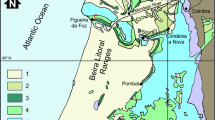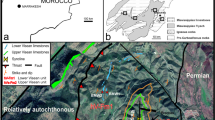Abstract
The scleractinian corals from the carbonate facies of the Oligocene–early Miocene (?) Qom Formation in Dizlu area (northern Isfahan), central Iran were described in three separate coral intervals. From the base to the top of the study carbonate sequence, the coral assemblages of the intervals include 1—Madracis, 2—Leptoseris–Stylophora and 3—Poritidae–Faviidae–Siderastreidae. The species identified within the carbonates are dominated by: Goniopora sp., Pachyseris sp., Madracis cf. ornate, Madracis sp., Montastraea parva, Solenastrea cf. desmoulinsi, Tarbellastraea reussiana, Stylophora sp., Siderastrea crenulata and Leptoseris sp. The identified colonial coral species were not colonizing through a strong carbonate reefal structure. Instead, they were distributed as sparse patches or building coral biostromal frameworks. The thin branching colonies of Madracis species and the second coral assemblage (Leptoseris–Stylophora) that is dominated by thin branching and thin platy colonial growth forms reflect deeper depths of a carbonate ramp with low light intensity within the lower photic zone in a depth range of 19–35 m and a maximum flooding surface. The coral associations of the Poritidae–Faviidae–Siderastreidae assemblage are mainly composed of massive colonies indicating the upper photic zone with depth of less than 20 m and a higher energy water regime. The three coral assemblages reflect marine paleotemperature of 19–20° C, respectively.







Similar content being viewed by others
References
Adams TD, Bourgeois F (1967) Asmari biostratigraphy: Iranian Oil Operating Companies, Geological and Exploration Division, Report 1074
Barattolo F, Bassi D, Romero R (2007) Upper Eocene larger foraminiferal–coralline algal facies from the Klokova Mountain (south continental Greece). Facies 53:361–375
Blainville HMD de (1830) Ovum, p. 184. In: Cuvier FG (ed) Dictionnaire des sciences naturelles, vol 60. F.G. Levrault, Paris and Le Normant, Strasbourg, pp 1816–1830
Bosellini A (ed) (1996) Geologia delle Dolomiti. Athesia, Bolzano, 192 p
Bosellini FR, Perrin C (2008) Estimating Mediterranean Oligocene–Miocene sea-surface temperatures: an approach based on coral taxonomic richness. Palaeogeogr Palaeoclimatol Palaeoecol 258:71–88
Brandano M, Tomassetti L, Bosellini F, Mazzucchi A (2010) Depositional model and paleodepth reconstruction of a coral-rich, mixed siliciclastic-carbonate system: the Burdigalian of Capo Testa (northern Sardinia, Italy). Facies 56:433–444
Catullo T (1852) Cenni sopra il terreno di sedimento superiore delle Province Venete e descrizione di alcuni polipari fossili ch’esse racchiude. Mem. I. R. Ist. Veneto Scienze, Lettere e Arti., vol. 4, 44 pp 1847–1852
Catullo T (1856) Dei terreni di sedimento superiore delle Venezie e dei fossili Bryozoari, Antozoari e Spongiari. Angelo Sicca, 1–8, 1–88, tavv. 1–19, Padova
Chappell JMA (1980) Coral morphology, diversity and growth. Nature 286:249–252
D’Achiardi A (1866) Corallari fossili del terreno nummulitico delle Alpi Venete. Parte 1ª con 5 tavole; pag. 54 in 4°. Memorie della Società italiana di Scienze naturali, tomo II, n. 4. Milano
Dana JD (1846) Zoophytes: US Explor Exped. 7:740 pp. Atlas 61 pls
Daneshian J, Ramezani Dana L (2007) Early Miocene benthic foraminifera and Biostratigraphy of the Qom Formation, Deh Namak, Central Iran. J Asian Earth Sci 29:844–858
Defrance JLM (1826) Conchyliologie et Malacologie. In: Levrault FG (ed). Dictionnaire des Sciences Naturelles, vol 10, pp 1–36
Dodd JR, Stanton RJ (1990) Paleoecology: concepts and applications. Wiley, New York
Duncan PM (1880) Sind fossil corals and Alcyonaria. Memoirs of the Geological Survey of India, Palaeontologica Indica, Series 7 and 14, vol 1, no. 1, pp 1–110
Felix J (1884) Korallen aus àgyptischen Tertiàrbildungen. Zeitschr D Geol Ges 36
Flügel E (2004) Microfacies of carbonate rocks. Analysis, interpretation and application. Springer, Berlin
Geel T (2000) Recognition of stratigraphic sequences in carbonate platform and slope deposits: empirical models based on microfacies analysis of Paleogene deposits in southeastern Spain. Palaeogeogr Palaeoclimatol Palaeecol 155:211–238
Graus RR, Macintyre IG (1976) Light control of growth form in colonial reef corals: computer simulation. Science 193:885–897
Insalaco E (1998) The descriptive nomenclature and classification of growth fabrics in fossil scleractinian reefs. Sed Geol 118:159–186
Jackson JBC (1979) Morphological strategies of sessile animals. In: Larwood G, Rosen BR (eds) Biology and systematics of colonial organisms, systematics association special volume, vol 11. Academic Press, London, pp 499–555
James NP (1984) Reefs. In: Walker RG (ed) Facies models. Geoscience Canada reprint series. Geological Association of Canada, pp 229–244
James NP, Ginsburg RN (1979) The seaward margin of Belize Barrier and Atoll reefs. International Association of Sedimentologists Special Publication, vol 3, 191 pp)
Karabiyikoglu M, Tuzcu S, Ciner A, Deynoux M, Örcen S, Hakyemez A (2005) Facies and environmental setting of the Miocene coral reefs in the late-orogenic fill of the Antalya Basin, western Taurides, Turkey: implications for tectonic control and sea-level changes. Sed Geol 173:345–371
Laursen GV, Mobini S, Allan TL, Pickard NAH, Hosseiney A, Vincent B, Hamon Y, Van-Buchem FSP, Moallemi A, Druillion G (2009) The Asmari Formation revisited: changed stratigraphic allocation and new biozonation. In: First international petroleum conference and exhibition, European association of geoscientists and engineers, Shiraz
Link HF (1807) Beschreibung der Naturalien-Sammlung der Universitaet zu Rostock, Abteilung 3. Gedruckt bey Adlers Erben, Rostock, pp 101–165
Mannani M (2010) Biostratigraphy and lithostratigraphy of Rhaetian to Liassic depositions in the North of Isfahan area. PhD dissertation, University of Isfahan
Mateu-Vicens G, Hallock P, Brandano M (2008) A depositional model and paleoecological reconstruction of the lower Tortonian distally steepened ramp of Menorca (Balearic Islands, Spain). Palaios 23:465–481
McCall J, Rosen B, Darrell J (1994) Carbonate deposition in accretionary prism settings: early Miocene coral limestones and corals of the Makran Mountain Range in southern Iran. Facies 31:141–178
Michelin H (1842) Iconographie zoophytologique. Description par localites et terrains des Polypiers fossiles de France et pays environnants (1840–1847), 79 tavv., Paris, 348 p
Michelotti G (1847) Description des fossiles des terrains miocènes de l’Italie septentrionale. Natuurk. Verh. Holl. Maatsch. Wetensch. Haarlem (2), vol 3
Milne Edwards H, Haime J (1848) Observations sur les polypiers de la familie des astréides. Academie de Science, Paris, Compte Rendu 27:466–469
Milne Edwards H, Haime J (1849) Recherches sur les polypiers. Quatrième mémoire. Monographie des Astréides. Annales des Sciences Naturelles, Paris, Sér. 3 12:95–197
Mohammadi E, Safari A, Vaziri-Moghaddam H, Vaziri MR, Ghaedi M (2011) Microfacies analysis and paleoenviornmental interpretation of the Qom Formation, South of the Kashan, Central Iran. Carbonates Evaporites 26:255–271
Oken L (1815) Lechbuch Naturgeschichte. (3) Zoologie. Schmid, Jena, pp 1–850
Perrin C, Bosellini FR (2012) Paleobiogeography of scleractinian reef corals: changing patterns during the Oligocene–Miocene climatic transition in the Mediterranean. Earth Sci Rev. doi:10.1016/j.earscirev.2011.12.007
Perrin C, Kiessling W (2010) Latitudinal trends in Oligo–Miocene reef patterns and their relationship to climate. In: Mutti M, Piller WE, Betzler C (eds) Carbonate systems during the Oligocene–Miocene climatic transition. IAS Special Publication, vol 42. Wiley, New York, pp 17–34
Pomar L (1991) Reef geometries, erosion surfaces and high frequency sea-level changes, Upper Miocene reef complex, Mallorca, Spain. Sedimentology 38:243–270
Pomar L, Hallock P (2007) Changes in coral-reef structure through the Miocene in the Mediterranean province: adaptive vs. environmental influence. Geology 35:899–902
Quenstedt FA (1881) Petrefactenkunde Deutschlands. Der ersten Abtheilung sechster Band. Korallen (Röhrenund sternkorallen). Fues’s Verlag (R. Reisland), Leipzig, 912 p
Rahiminejad AH, Yazdi M, Ashouri AR (2011) Miocene scleractinian corals from a mixed siliciclastic-carbonate system: Bakhtiari succession, Zagros Basin (central-western Iran). Alcheringa 35:571–592
Renema W (2006) Large benthic foraminifera from the deep photic zone of a mixed siliciclastic-carbonate shelf off East Kalimantan, Indonesia. Mar Micropaleontol 58:73–82
Reuss AE (1864) Die fossilen Foraminiferen, Anthozoen und Bryozoen von Oberburg in Steiermark. Denkschr. kais. Akad. Wiss. Wien, math.naturw. CI., vol. 23
Reuter M, Piller WE, Harzhauser M, Mandic O, Berning B, Rögl F, Kroh A, Aubry MP, Wielandt-Schuster U, Hamadani A (2009) The Oligo-/Miocene Qom Formation (Iran)—evidence for an early Burdigalian restriction of the Tethyan Seaway and closure of its Iranian gateways. Int J Earth Sci 98:627–650
Riegl B, Piller WE (1997) Distribution and environmental control of coral assemblages in northern Safaga Bay (Red Sea, Egypt). Facies 36:141–162
Riegl B, Piller WE (2000) Biostromal coral facies—a Miocene example from the Leitha Limestone (Austria) and its actualistic interpretation. Palaios 15:399–413
Sadeghi R, Vaziri-Moghaddam H, Taheri A (2011) Microfacies and sedimentary environment of the Oligocene sequence (Asmari Formation) in Fars sub-basin Zagros Mountains, southwest Iran. Facies 57:431–446
Schuster F (2002a) Early Miocene scleractinian corals from the Qom and Asmari formations (central and southwest Iran). Courier Forschungsinstitut Senckenberg 239:129–161
Schuster F (2002b) Taxonomy of Oligocene to Early Miocene scleractinian corals from Iran, Egypt, Turkey, and Greece. Courier Forschungsinst. Senckenberg. 239:1–3
Schuster F, Wielandt U (1999) Oligocene and Early Miocene coral faunas from Iran: palaeoecology and palaeobiogeography. Int J Earth Sci 88:571–581
Schweigger AF (1819) Beobachtungen auf naturhistorischen Reisen. Reime, Berlin, pp i–vii, 1–128
Seyrafian A, Toraby H (2005) Petrofacies and sequence stratigraphy of the Qom Formation (Late Oligocene- early Miocene?), north of Nain, southern trend of central Iranian basin. Carbonates Evaporites 20:82–90
Seyrafian A, Vaziri-Moghaddam H, Arzani N, Taheri A (2011) Facies analysis of the Asmari Formation in central and north-central Zagros basin, southwest Iran: Biostratigraphy, paleoecology and diagenesis. Revista Mexicana de Ciencias Geológicas 28:439–458
Sheppard CRC (1982) Coral populations on reef slopes and their major controls. Mar Ecol Prog Ser 7:83–115
Stöcklin J, Setudehina A (1991) Stratigraphic lexicon of Iran. Geology Survey of Iran, Report 18, pp 1–376
Toraby H (2003) Stratigraphy of Oligocene–Miocene Sediments (Qom Formation), West Ardestan–North Nain. PhD dissertation. University of Isfahan
Tsaparas N, Marcopoulou-Diacantoni A (2005) Tortonian scleractinian corals from the island of Gavdos (South Greece). Revue de Pale′obiologie 24:629–637
Van Buchem FSP, Allan TL, Laursen GV, Lotfpour M, Moallemi A, Monibi S, Motiei H, Pickard NAH, Tahmasbi AR, Vedrenne V, Vincent B (2010) Regional stratigraphic architecture and reservoir types of the Oligo-Miocene deposits in the Dezful Embayment (Asmari and Pabdeh Formations) SW Iran, vol 329. Geological Society, London, Special Publications, pp 219–263
Vaughan TW (1919) Fossil corals from Central America, Cuba, and Porto Rico, with an account of the American Tertiary, Pleistocene, and Recent coral reefs. Smithson Inst Bull 103:189–524
Vennin E, Jean-Marie R, Chaix C, Valleron MMB, Caruso A, Rommevau V (2004) Paleoecological constraints on reef-coral morphologies in the Tortonian–early Messinian of the Lorca Basin, SE Spain. Palaeogeogr Palaeoclimatol Palaeoecol 213:163–185
Veron JEN (1995) Corals in space and time. University of New South Wales Press, Sydney
Weil E, Knowlton N (1994) A multi-character analysis of the Caribbean coral Montastraea annularis (Ellis and Solander, 1786) and its two sibling species, M. faveolata (Ellis and Solander, 1786) and M. franksi (Gregory, 1895). Bull Mar Sci 55:151–175
Wynd JG (1965) Biofacies of the Iranian consortium agreement area: Iranian Oil Offshore Company Report 1082, unpublished
Acknowledgments
We hereby gratefully thank Prof. Ann Budd from the University of Iowa for her valuable helps in taxonomy identification of the coral species.
Author information
Authors and Affiliations
Corresponding author
Rights and permissions
About this article
Cite this article
Yazdi, M., Shirazi, M.P., Rahiminejad, A.H. et al. Paleobathymetry and paleoecology of colonial corals from the Oligocene–early Miocene (?) Qom Formation (Dizlu area, central Iran). Carbonates Evaporites 27, 395–405 (2012). https://doi.org/10.1007/s13146-012-0122-5
Accepted:
Published:
Issue Date:
DOI: https://doi.org/10.1007/s13146-012-0122-5




